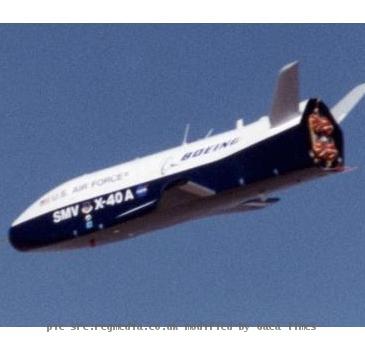X-37 Details
By Soumitra Mondal, Gaea News NetworkSaturday, March 20, 2010
San Francisco (GaeaTimes.com) X-37 is a brand new mini robotic space shuttle that will be launched the next month. The spaceplane is named Boeing X-37 B Orbital Test Vehicle. The size of the space shuttle is about one fourth of the size of a standard space shuttle. It was initially intended to carry astronauts but later the project was handed over from NASA to United States Air Force and will launch into space without a single crew. It is reported that the unmanned spacecraft can fly home and land on its own. The spacecraft is believed to be used for intelligence gathering or delivering small satellites and the Air Force reportedly said that it would be used for space experimentation, risk reduction and development of reusable space vehicle technologies. It is reported that it will undergo an initial launch on an Atlas V rocket on April 19 from Cape Canaveral Air Force Station, Fla.
It is developed in the Boeing’s Phantom Works and much details of the project are not yet available. It is now kept at the Astrotech hangar in Titusville. The size of the craft measures nearly 30 feet long, about 10 feet tall and a 14 ft 11 inch wingspan. The loaded weight of the spaceplane is supposed to be around 12,000 lb or about 5,450 Kg. The powerplant of the vehicle is a single Rocketdyne AR-2/3. It was initially intended to be launched at the back of a space shuttle as a manned ‘lifeboat’ re-entry craft for the crew of the International Space Station but later the ‘lifeboat’ was selected to be an ordinary Russian Soyuz capsule. But the project carried on only after changing the hands from NASA to US Air Force Rapid Capabilities Office. The new space shuttle was named X-37 B and was developed from NASA’s X-37 A. It is now a robotic spaceshuttle which can remain in orbit for substantial periods of time and then can re-enter the atmosphere for a runway landing automatically.
It had landing tests in California and was reported to be dropped from high in the stratosphere on Sept 2, 2004, by the White Knight mothership that was previously used as the carrier of the SpaceShip One suborbital rockletplane for the first stage of its journey. On March 10, 2006 it was scheduled for a public debut with its first free flight but an Arctic Storm covered the area on the Majave and the flight was cancelled. Things didn’t go all smoothly and the X-37 allegedly had some hiccups during the tests that included an incident of running off the end of the runway at Edwards Air Force Base in California.
Though we have the date of its launch we still have no information about its date of return to earth and anything regarding the payload of the vehicle.
According to the Rapid Capabilities Office:
The X-37B has the requirement to be on-orbit up to 270 days. Actual length for the first mission will depend on the meeting the mission objectives, which consists of checkout and performance characteristics of the spacecraft systems.
Objectives of the OTV [Orbital Test Vehicle] program include space experimentation, risk reduction and concept of operations development for reusable space vehicle technologies.
(Source: https://www.theregister.co.uk/2010/03/15/x_37_go_for_april/)
